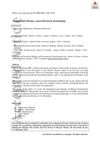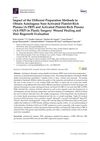TLDR Platelet-rich plasma therapy helps heal skin ulcers and stimulates hair growth in dermatology.
The document discussed the rapidly expanding use of platelet-rich plasma (PRP) in dermatology, particularly for chronic cutaneous ulcers and aesthetic applications. PRP contains bioactive molecules like type 2 fibroblastic growth factor (FGF-2) and platelet-derived growth factor (PDGF), which aid in tissue healing by promoting angiogenesis and dermal fibroblast proliferation. Additionally, FGF-7, or epidermal growth factor, was highlighted for its role in activating keratinocyte proliferation and stimulating hair growth.
 33 citations
,
February 2019 in “Journal of Tissue Engineering and Regenerative Medicine”
33 citations
,
February 2019 in “Journal of Tissue Engineering and Regenerative Medicine” Platelet-Rich Plasma (PRP) shows promise for treating various skin conditions, but more research is needed to standardize its use.
 58 citations
,
January 2020 in “International Journal of Molecular Sciences”
58 citations
,
January 2020 in “International Journal of Molecular Sciences” Different methods of preparing Platelet-Rich Plasma (PRP) can affect wound healing and hair regrowth in plastic surgery. Using a kit with specific standards helps isolate PRP that meets quality criteria. Non-Activated PRP and Activated PRP have varying effects depending on the tissue and condition treated. For hair regrowth, Non-Activated PRP increased hair density more than Activated PRP. Both treatments improved various aspects of scalp health.
12 citations
,
June 2023 in “International Journal of Molecular Sciences” Innovative biomaterials show promise in healing chronic diabetic foot ulcers.
48 citations
,
December 2022 in “Biomolecules” 3D bioprinting shows promise for creating advanced skin for healing wounds and reducing animal testing.
 7 citations
,
December 2018 in “Discoveries”
7 citations
,
December 2018 in “Discoveries” Platelet-rich plasma may improve wound healing by stimulating cell growth and blood vessel formation.



